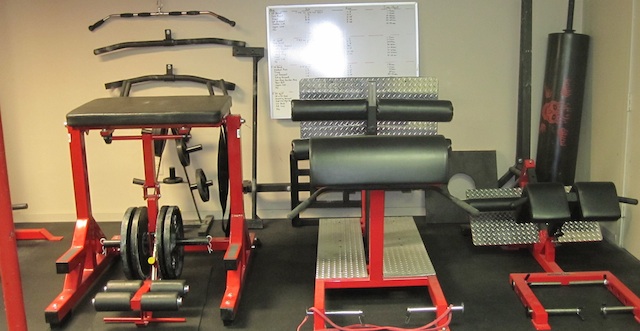
Not too many years ago, Brian Reed was a track and field athlete at a D1 university. The decathlon was his life. To him, the weight room was a place to train the Olympic lifts so that he could run faster, jump higher, and throw farther. Brian isn’t afraid to say that he never would have gone to college if it weren’t for track and field.
Brian was pursuing an exercise science degree and therefore had a pretty good chance of journeying down the strength training rabbit hole. It started with his mentor, a strongman named Reggie Barton, who taught him how to lift. Reggie insisted on perfection in every movement, whether it was the squat or a clean, a lesson that was immensely valuable.
Eventually, Brian began working as a strength coach at his university. He learned the art of proper programming and was able to work with all kinds of athletes, as well as experiment on himself. Today he owns a gym in Yardley, PA called VIP Training and Strength Sport. He’s a lifter first, then a coach. Brian believes that a good lifter can easily become a good coach, but a good coach can’t just become a good lifter.
How did he become a gym owner? During and after college, he trained clients at a local commercial gym. It didn’t take long for him to realize that the faults of the commercial gym were holding him and his clients back. He knew he wouldn’t get where he wanted to be if he remained in the commercial gym, with its lack of quality equipment and lax atmosphere.
At 24 years old, Brian couldn’t get a loan and he had no capital, but he wouldn’t let that stop him. He called Jim Wendler at elitefts™ and maxed out 10 credit cards worth of new equipment.
VIP Training and Strength Sport is a small, private facility that trains everyone from young gymnasts to senior citizens. The gym is going on five years at this point. Brian knew that he needed equipment that could stand up to his own abuse as well as the work his clients put in, which is why he called elitefts™. His personal favorite piece of equipment is the EFS Signature Monolift, as he just started wearing gear and needs a monolift for squatting. For clients, even the old folks, he loves the Pro GHR. Among other things, he’s got a yoke, farmer’s handles, cable attachments, dumbbells, 0-90 benches, a lat pulldown, reverse hyper, competition bench, two racks, a platform, and a functional trainer, almost all of which are from elitefts™. He especially loves the UHMW Prowler Skis, as he was banned from using the Prowler outside his building!
At VIP, everyone works hard and everyone’s programming is a variation of Brian’s four-day split. When it comes to the business side of things, Brian isn’t so much selling his facility as he is selling his programming. He wants his clients to understand the training and learn from it. He proudly says that people often come to the gym to get in better shape and “they don’t realize what they’re turning into.” He’s had 50-year-old men go from first-timers to winning their class at a meet. A lot of his clients end up competing because of the methods used at the gym.
Without going into too much detail, Brian’s training philosophy –and that of the two other trainers at VIP- is that maximal strength is the basis for everything else. Beginners will utilize sub-maximal loads so they can see results and learn movements properly, while advanced clients are using the conjugate system. Brian is a huge proponent of dynamic effort, so much so that every third week of his own training, he “deloads” by doing speed work only.
When I asked Brian what he thinks is wrong with training today, he said that it’s a lack of programming and tracking. “Most people today don’t program at all, which leads to over- or under-training.” At VIP, Brian logs every client’s training to ensure progress. He’s thankful he burned himself out so many times during his college days, because it helped him get a real-world understanding of how to periodize a program and keep people strong and fresh with proper peaks and deloads.
As for what’s right about training today, Brian immediately praised the speed and availability of information. In a matter of seconds, you can be reading a translated Soviet text, or get up-to-the-second updates from competitions. He is also impressed by the speed at which underground trainees are progressing strength sports. In 2007, Brian made the Powerlifting Watch Top 50. Today, he says, the numbers these guys put up are just insane. Comparing the numbers of today with those of just four years ago will show you the huge leap powerlifting has taken.
In closing, I asked Brian for some advice for folks wanting to open their own training facility. His answer: “Have a plan. Get a good lawyer to handles leases and things for you unless you have the knowledge to do it.” He also recommends adopting a DIY mentality. For example, Brian saved $25,000+ by doing the demolition work in his building by himself.
"Obviously, you’ve got to offer a unique training experience," he says. Near VIP are two large big-box gyms, but that’s ok with Brian. “It drives the right kind of people to my place,” he says of the commercial competition. You can’t be scared of the big gyms. “They just have money for advertising, that’s it. They don’t offer a superior product.”
What it really takes to be successful is a combination of planning and drive. In the beginning, Brian did whatever it took to make his business successful, and he’s reaping the benefits now. Brian is a great guy and an outstanding coach who gets results. If you’re ever in the Philadelphia/Trenton area, swing by Yardley and see what VIP can offer you.











